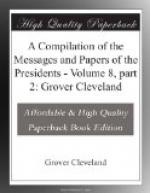The duty which these gentlemen performed was arduous in the extreme. It has been seen that on the expedition up the Metis a seasoned voyageur had been worn out by the severity of his labors; on the Tuladi half the men were sick at a time; and of Mr. Rally’s party two Penobscot Indians of herculean frame were compelled to return by extreme fatigue. The engineers, while in the field, were even more exposed to fatigue than the laborers, for they carried their own baggage and instruments, and were engaged nightly in observation and calculation, while the workmen could repose.
27. The commissioner to whom the survey of the northern division of the boundary line was intrusted has to express his acknowledgments for the politeness and good offices of the authorities of Her Britannic Majesty. In compliance with his request, permission was granted by the late lamented Governor-General for the admission of a vessel and the entry of the stores, camp equipage, and instruments of the party at one or more ports on the St. Lawrence. Letters were addressed by the principal secretary of the colony of Canada to all the officers and magistrates, directing them to give every facility to the operations, and these directions were obeyed, not as mere matters of form, but with a truly hospitable spirit. To the officers of the Sixty-eighth Regiment, forming the garrison of Fort Ingall and occupying the post of the river Du Loup, as well as to the officers of the commissariat on duty at those places, acknowledgments are due for numerous attentions.
II.—Operations of the year 1842.
1. Of the task originally assigned in the instructions for this division there remained to be completed—
(1) A portion of the boundary claimed by the United States around the head waters of the river Rimouski.
(2) The line of highlands forming the south bounds of the Province of Quebec, extending from the north shore of the Bay of Chaleurs at its western extremity.
2. Experience had shown that the portion of the boundary which remained unsurveyed could not be reached with any hope of completing the survey by any of the streams running into the St. Lawrence nor from the waters of Lake Temiscouata. The Green River (of St. John) was therefore chosen as the line of operation. It was known that a portage existed between its boatable waters and those of the Grande Fourche of Restigouche. The plan for the work of the season was therefore laid as follows:




